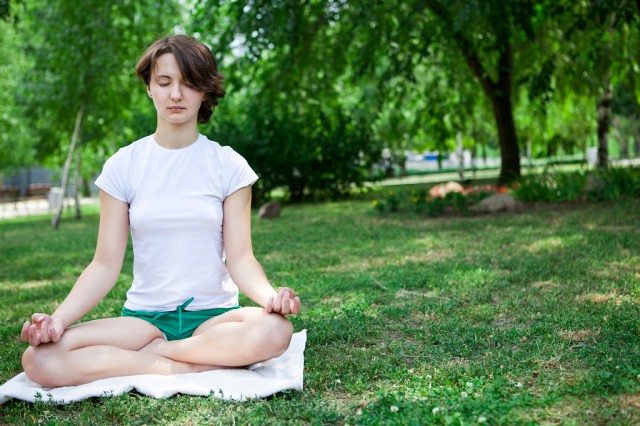The Mental Benefits of Yoga
By Sherry Roberts
John McEnroe and Jeff Tarango, two of the fiercest characters to ever smash a tennis racquet, as poster boys for yoga? That’s what the December 2000 issue of Tennis magazine claims. According to Tennis, a number of tennis players are turning to yoga and meditation to pick them up when their backhand lets them down. But is this another gimmick to pacify desperate tennis players?
It’s a head game
As a tennis player who has struggled with the green fuzzy ball for more than 15 years, I can attest to the fact that tennis is as much a mental sport as a physical one. There is no other explanation for why top tennis professionals — who have all the strokes, power, speed, and finesse — crash and burn on the red clay of Roland Garros or the green grass of Wimbledon. Every one of us — whether we are scrambling to get a racquet on a serve at the U.S. Open or running down drop shots at the local public courts — play tennis to experience one emotion: to play “in the zone.”
Playing in the zone can be pure bliss. Impossible shots go in. The small tennis ball seems as big as a basketball. Each hit is solid and smooth and blessed, it seems. When you are in the zone, your focus is laser-sharp. Since yoga and meditation help refine our focusing skills, it makes sense that they can help us enter “the zone” more frequently. In yogic terms, we call it living “in the moment.” I personally use breath control — slow, deep breaths before serving or between points — to center myself, relax, and bring myself back to the moment. Breath control is part of every yoga asana or posture. Arthur Ashe used this technique in the 1975 Wimbledon final, in which he upset the legendary Jimmy Connors. During changeovers, Ashe covered his head with a towel and calmed himself with controlled breathing.
The mind-body stretch
The physical benefits of yoga — increased strength, stamina, balance, and flexibility — help tennis players meet the rigors of the game. Tennis is a game that is always throwing your body physically out of balance. The elbow and wrist in your dominant arm take a beating as do your knees, calves, and ankles (depending on the type of surface you play on). Backs get jerked and twisted during the service and as you lunge for passing shots.
I discovered yoga while recovering from plantar fasciitis in both arches. This is a common injury among tennis players, who will hobble through match after the match if you let them. I finally gave in to the pain, went to a doctor, and started the treatment for repairing my arches: anti-inflammatory drugs, orthotics, and rest — months of boring rest. Being banned from the tennis court for months is an invitation to madness for most tennis players. I saw yoga as a temporary measure to save my sanity; instead, it changed my life. When I returned to the tennis courts after months of practicing yoga, I felt stronger — both physically and mentally. I felt greater flexibility in my back and shoulders, especially on the rotation during my service, and in injury-prone joints.
But best of all, I learned there is a tremendous world off the court. Yoga unfurled my tunnel vision and showed me there are other paths to personal growth and development.
Which poses are helpful for tennis players?
Tennis magazine suggests four asanas for tennis players:
Tree pose (vrksasana) to strengthen the legs, open the hips, and improve balance and coordination.
Triangle pose (trikonasana) to strengthen and stretch the hamstrings, open the chest, and promote balance.
Warrior II pose (virabhadrasana II) to strengthen quads, calves, and Achilles’ tendons; expand range of motion; and teach you to move from the hips.
Spinal twist pose (ardha matsyendransana) to limber hips and shoulder joints and tone and stretch the lumbar spine.
In its May/June 2000 issue, Yoga Journal noted that yoga silences the “inner chatter” and helps tennis players strengthen injury-prone joints. It highlighted these asanas for courtside yogis:
Warrior II pose (virabhadrasana II) to develop strength and balance.
Chair pose (utkatasana) to create space throughout the ankle and knee joint; lengthen the Achilles’ tendons, calves, and spinal column; and firm the abdomen.
Bridge pose (setu bandha) to develop a supple back and torso.
Handstand (adho mukha vrksana) to build mental and physical focus and agility.
Some of these poses, such as the handstand, are quite difficult and should not be attempted without a qualified teacher. We recommend attending a yoga class regularly to have a real impact on your tennis game and also incorporating some poses you have learned in class in your pre-match stretching ritual.
The dance of tennis
Some tennis pros have begun including yoga and meditation techniques in their classes and lessons. Before you sign up for a tennis camp, ask the instructor if yoga is part of the program. One facility that uses yoga to create focus is the Dance of Tennis Center in Richmond, Massachusetts. Owner and former tennis pro Jena Marcovicci says, “Research shows the discipline required for yoga can take you to a state of meditation. It releases endorphins, calms your pulse, and slows your nervous system. That’s the zone you want to be in as you walk on the court.”
Let yoga put you “in the zone” — both on, and off the court.

